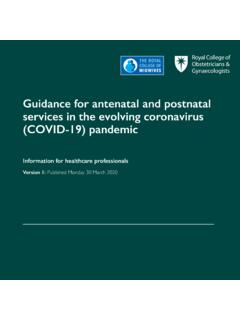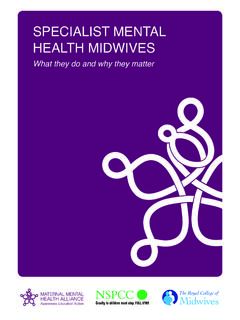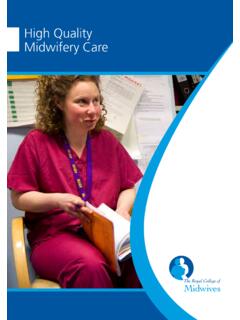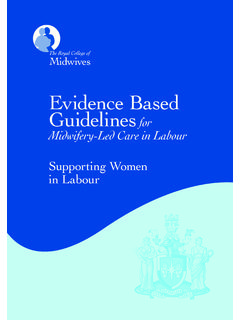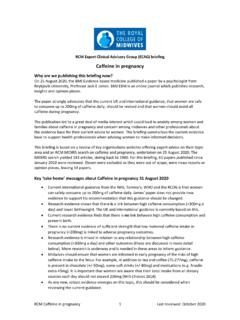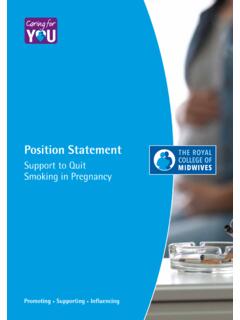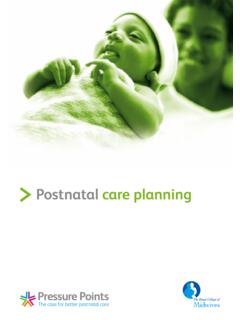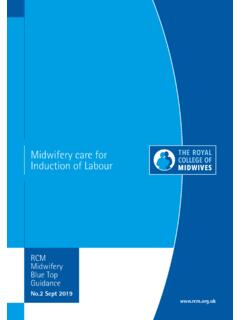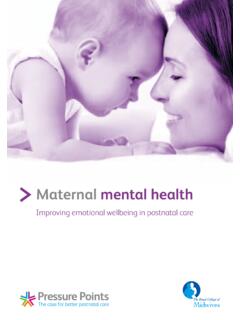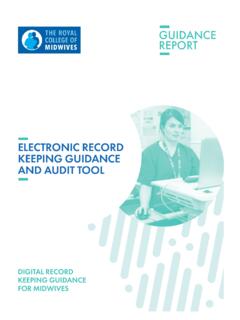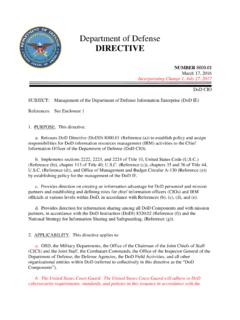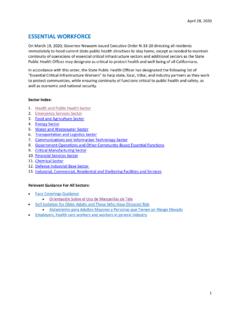Transcription of Getting the midwifery - RCM
1 The midwifery workforce right1 | The Royal College of MidwivesGetting the midwifery workforce | 2 Key messages The role of the midwife is clearly described and demarcated. The evidence shows that it is in the interests of women to receive the majority of their care from a small group of midwives they know and trust. midwifery services should be staffed to enable this to happen. The role of the midwife has developed over the years to meet changing population needs and in a changing context of healthcare delivery. The role of the midwife can encompass new tasks but this should always be a) in the interests of women and their babies b) properly resourced c) supported by defined competencies and appropriate education and d) within their scope of practice. When a midwife takes on new tasks this does not equate to taking on a specialist or advanced role. A midwife may focus her skills on a specific group of women teenage mothers, women with drug or alcohol problems, safeguarding etc.
2 This does not make her a specialist or advanced midwife. A specialist midwife would be expected to play a more strategic role in service delivery. A specialist midwife would be expected to receive referrals from other midwives or GPs when care was particularly complex. She would also be expected to network amongst other services , have a role in policy influencing and setting for that service and a key role in education. Specific local circumstances primarily related to size of service and rural services may exceptionally mean it is appropriate for a midwife to undertake tasks which in another context are usually performed by other professionals scrubbing in theatre or undertaking ventouse deliveries. Support workers play a vital part in maternity teams. They may be employed in clerical, housekeeping or care giving roles. MSWs in particular make an important contribution. There should be a nationally agreed framework with competencies for such roles supported by national training programmes.
3 There is no need for a nurse associate role in maternity services . Consultant midwives have clearly defined roles, make an enormous difference to the clinical leadership and practice development within units as well as being the catalysts for change and | The Royal College of MidwivesGetting the midwifery workforce | 4 Role of the midwifeThe role of the midwife is to ensure that women receive the care they need throughout pregnancy, childbirth and the postnatal period. Much of this care will be provided directly by the midwife, whose expertise lies in the care of women and babies during normal birth and pregnancy. Where obstetric or other medical involvement is necessary, the midwife continues to be responsible for providing holistic support, maximising continuity of carer and promoting a positive birth experience for the way in which the role of the midwife evolves and develops over time may have significant implications for the overall focus and quality of midwifery care, on the best use of resources and on the midwifery profession itself.
4 That is why the RCM has developed this guidance for midwives, MSWs, other members of the maternity team, midwifery service providers and policy of the roleThe formal definition of a midwife that has been adopted by the International Confederation of Midwives (ICM), the International Federation of Gynaecologists and Obstetricians (FIGO) and the WHO reads as follows: A midwife is a person who, having been regularly admitted to a midwifery educational programme, duly recognised in the country in which it is located, has successfully completed the prescribed course of studies in midwifery and has acquired the requisite qualifications to be registered and/or legally licensed to practise must be able to give the necessary supervision, care and advice to women during pregnancy, labour and the postpartum period, to conduct deliveries on her own responsibility and to care for the newborn and the infant. This care includes preventative measures, the detection of abnormal conditions in mother and child, the procurement of medical assistance and the execution of emergency measures in the absence of medical help.
5 She has an important task in health counselling and education, not only for the women, but also within the family and the community. The work should involve antenatal education and preparation for parenthood and extends to certain areas of gynaecology, family planning and child care. She may practise in hospitals, clinics, health units, domiciliary conditions or in any other service. IntroductionMaternity services like the rest of the NHS are facing severe financial challenges. The paradox for everyone involved in funding, managing and delivering maternity services is how on the one hand: The NHS could and should raise its game on personalised support to parents and their babies, better team working, better use of technology and more joined up maternity services (Simon Stevens, CEO NHS England)But on the other hand: cuts in staffing and reduction in quality are inevitable if the government s priority is to restore the NHS to financial balance (Kings Fund 2016)In order to try to bring some clarity into debates, policies and decisions about how maternity services should be configured, funded and staffed, the RCM has developed this guidance which explains the role of the midwife, the limits and scope of the role, its relationship with other professionals and care givers and the approaches which are most likely to lead to safe and effective staffing | The Royal College of MidwivesGetting the midwifery workforce | 6 Thinking about midwifery in 2016 The role of the midwife as primary carer for women and infants experiencing normal pregnancy and birth has remained essentially unchanged for many years.
6 The value of this role lies in midwives extensive knowledge, expertise and their ability to detect and act appropriately on a wide range of clinical and other indicators in pregnancy, labour and the postnatal is very much relationship-focused rather than providing task or intervention based care. It has its biggest impact on outcomes where midwives are able to provide consistent care over the continuum of antenatal, intrapartum and postnatal care. The intention of delivering continuity of carer of each pregnant woman seeing as few different health care staff as possible, is central to policy for maternity services across the UK. This is not because midwives are territorial about their role but because they play a distinct role in caring for women and because of the wealth of evidence that shows continuity of care provided by a midwife is linked to the best clinical outcomes for women. Any discussion about the maternity workforce therefore needs to start from a clear understanding that the shared primary objective must be to have sufficient staff with sufficient skills/competence/expertise, to minimise the number of different contacts a woman will be required to have during her pregnancy, birth and early postnatal RCM affirms the ICM/FIGO/WHO definition of the role of the midwife and the definition contained in the European Union Midwives Directive.
7 However, whilst the role of the midwife and her scope of practice are established in statute, there is considerable pressure due to current policy initiatives and the changing context of service delivery for flexibility in the focus and emphasis of that role. The current emphasis on developing a flexible NHS workforce , are exacerbating these activities of a midwife are defined in the European Union Midwives Directive 80/155/EEC Article 4 as follows: Member states shall ensure that midwives are at least entitled to take up and pursue the following activities: to provide sound family planning information and advice to diagnose pregnancies and monitor normal pregnancies; to carry out examinations necessary for the monitoring of the development of normal pregnancies to prescribe or advise on the examinations necessary for the earliest possible diagnosis of pregnancies at risk to provide a programme of parenthood preparation and a complete preparation for childbirth including advice on hygiene and nutrition to care for and assist the mother during labour and to monitor the condition of the foetus in utero by the appropriate clinical and technical means to conduct spontaneous deliveries including where required an episiotomy and in urgent cases a breech delivery to recognise the warning signs of abnormality in the mother or infant which necessitate referral to a doctor and to assist the latter where appropriate; to take the necessary emergency measures in the doctor s absence, in particular the manual removal of the placenta, possibly followed by a manual examination of the uterus to examine and care for the newborn infant.
8 To take all initiatives which are necessary in case of need and to carry out where necessary immediate resuscitation to care for and monitor the progress of the mother in the postnatal period and to give all necessary advice to the mother on infant care to enable her to ensure the optimum progress of the newborn infant to carry out the treatment prescribed by a doctor to maintain all necessary records. For many years the legal definition of a midwife has been accepted by the regulators, the NHS and the profession itself, to encompass the care provided during pregnancy and the postnatal period. Practically this means that for the majority of women midwives make autonomous decisions without reference to a medical practitioner throughout the pregnancy continuum and take full responsibility for their decision making. Where necessary the midwife has a responsibility to refer women to appropriate professionals but to continue to provide | The Royal College of MidwivesGetting the midwifery workforce | 8 Accordingly, the RCM recognises that: local and national policy, strategy, population and staffing needs all legitimately shape the focus and emphasis of a midwife s daily work; the provision of safe, effective and high quality care requires a reasonable degree of flexibility on the part of staff groups and careful consideration of an appropriate skill mix for different maternity settings; midwives should acknowledge that even when they are the sole care giver, if women are to get safe care they must work within multi-disciplinary teams; and midwives are able to access opportunities to develop and enhance their skills and means that any work to review the skill mix in maternity must be focused on ensuring that women still receive care that is holistic as opposed to task orientated.
9 Other staff can and should normally be employed in support roles if this leads to greater efficiency, and appropriately educated staff may undertake delegated roles again if this does not undermine the basic principle of women receiving the bulk of their care from an appropriately qualified professional they know and order to achieve this it is important to sustain a clear definition of the role of the midwife, in order to ensure consistency in standards of care and the continued advancement of a defined midwifery body of knowledge. The RCM welcomes any development of the midwife s role which enhances these skills and expertise, or which makes midwifery care more accessible and responsive to women s needs. In the context of ensuring that women are able to exercise choice about the care they receive it is critically important to ensure that there are midwives in the workforce who are competent to: work in different settings and to address particular needs which impact on maternal and infant wellbeing (for example domestic violence, substance misuse, homelessness); and work in new ways and partnerships to meet the range of women s needs to, for example, promote seamless care or reduce unnecessary delays or barriers such as distances in accessing care and to learn new have, however, proved adaptable in responding to changes in the context of their role, and in the settings and systems within which midwifery care is provided.
10 In recent years midwives have become used to and grown in confidence in sharing some elements of care to maximise their | The Royal College of MidwivesGetting the midwifery workforce | 10 Midwives already take the lead in making decisions with women about the nature of their care and planning as well as providing hands-on care, as well as co-ordinating care with other specialist there are a number of developments that have the potential to impact on the role and scope of practice of midwives. These include: National policy drivers to enhance the role of the midwife, such as Better Births the report of the national maternity review in England, the Strategic Vision for Maternity services in Wales, the Strategy for Maternity Care in Northern Ireland and the forthcoming review of maternity services in Scotland. An increasing focus on the public health role of the midwife and the opportunity to deliver broader public health interventions as part of maternity care which expands the components of routine midwifery care1.
